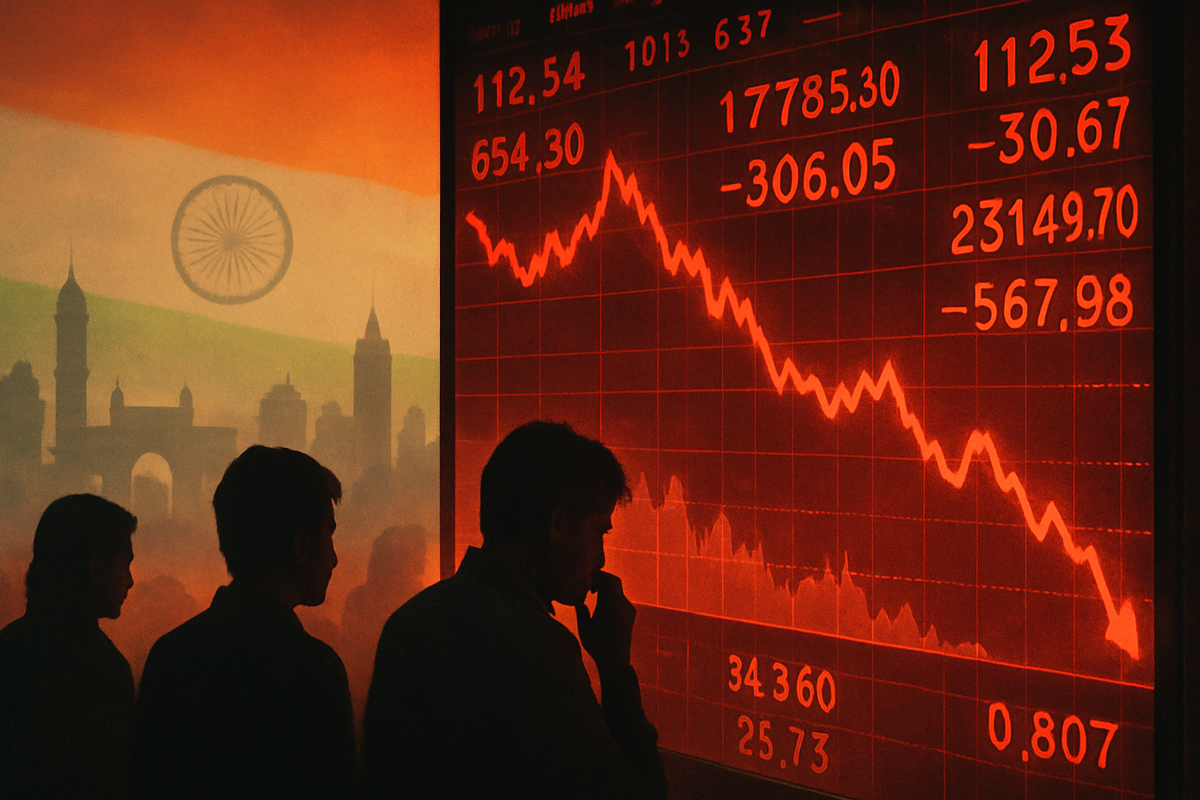
The Indian equity market is currently navigating a turbulent period, with benchmark indices Nifty and Sensex experiencing notable declines. This downturn is not isolated to the large-cap segment; broader markets, including the Nifty Midcap 100 and Nifty Smallcap 100, are witnessing even sharper corrections, signaling a widespread sentiment of caution among investors. The immediate implications point to heightened volatility and a re-evaluation of investment strategies as both domestic and global headwinds exert pressure on the market.
This comprehensive overview delves into the specifics of the market's performance, identifies the key drivers behind the current weakness, and explores the potential ramifications for various sectors and individual companies. Understanding these dynamics is crucial for investors seeking to navigate the evolving landscape of the Indian financial markets.
What Happened and Why It Matters
The Indian stock market has been under considerable strain, marked by a consistent downward trend in its key indices. On August 6, 2025, the BSE Sensex declined by 166.26 points (0.21%) to close at 80,543.99, while the NSE Nifty 50 fell 75.35 points (0.31%) to settle at 24,574.20. This followed a significant drop earlier in August, with the Nifty slipping below the 24,700 mark and the Sensex shedding over 300 points on August 5, 2025. The Nifty 50 has also endured a five-month losing streak as of February 28, 2025, marking its longest such period since 1996, with a 15% decline since September 2024.
The weakness has been particularly pronounced in the broader market. On August 6, 2025, the NSE Midcap index declined by 0.8% and the Smallcap index lost over 1%, with the Nifty Midcap 100 tumbling 0.77% and the Nifty Smallcap 100 falling 1.10%. Earlier, on March 10, 2025, the Nifty Smallcap 100 Index experienced its sharpest fall since February 28, declining 1.89%, with 87 out of 100 stocks in the index declining. As of March 10, 2025, the Nifty Smallcap 100 had a year-to-date decline of 19%, and midcap stocks were down 20% as of February 28, 2025, indicating a bear market.
Several factors are contributing to this market pressure. Global trade tensions, particularly renewed threats and the imposition of higher tariffs by the US on Indian goods due to India's continued oil imports from Russia, have heightened uncertainty. This could significantly impact India's exports, GDP growth, and corporate earnings. Furthermore, persistent Foreign Institutional Investor (FII) outflows have been a major driver of the correction, with FIIs pulling out substantial capital, partly due to more attractive returns in the US bond market and a shift towards China. The Reserve Bank of India's decision to keep the repo rate unchanged at 5.5% on August 6, 2025, while expected, also disappointed investors hoping for more dovish signals. Weak corporate earnings from prominent companies like Adani Ports (NSE: ADANIPORTS), Reliance Industries (NSE: RELIANCE), and Infosys (NSE: INFY), coupled with concerns over overstretched valuations and rising oil prices, have further fueled the downturn.
Winners and Losers in a Volatile Market
In the midst of this broad market weakness, certain sectors and individual stocks have exhibited divergent performances, creating a landscape of both winners and losers. The Nifty Pharma index has shown resilience, emerging as a top performer, while the IT sector has faced significant headwinds.
The Nifty Pharma sector, surprisingly, was among the steepest decliners, falling 2% on August 6, 2025, and nearly 3% intraday on August 1, 2025. This downturn was primarily driven by uncertainty surrounding US trade policy, specifically threats from the US President to impose tariffs of up to 250% on pharmaceutical imports to encourage manufacturing shifts back to the US. Similarly, the Nifty IT sector also faced considerable pressure, with the Nifty IT index plunging 1.7% on August 6, 2025. Concerns over global technology spending, weak quarterly earnings guidance from major IT firms, and broader macroeconomic worries contributed to this weakness. Other underperforming sectors included Nifty Realty, Nifty FMCG, and Nifty Metal.
Among the key losers in the Nifty 50 and Sensex, Wipro (NSE: WIPRO) was a top decliner, falling 2.5% on August 6, 2025. The company's stock has been under sustained pressure due to weak Q4 FY25 earnings and a weak guidance for Q1 FY26, indicating a potential third consecutive year of revenue decline. Macroeconomic worries, US recession fears, a broader IT sector sell-off, and poor revenue conversion have also contributed to its underperformance. Sun Pharma (NSE: SUNPHARMA) also dropped 2.37% on August 6, 2025, and was the top loser in the Nifty 50 on August 1, 2025, sliding 5.7%. The primary factor for this decline was the uncertainty over tariffs on pharma products, coupled with a 20% year-on-year (YoY) decline in consolidated net profit for Q1 FY26. Other notable losers included Jio Financial Services (NSE: JIOFIN), Tech Mahindra (NSE: TECHM), and IndusInd Bank (NSE: INDUSINDBK).
Conversely, some companies managed to buck the trend and emerge as gainers. Asian Paints (NSE: ASIANPAINT) was a top gainer in the Nifty 50 on August 6, 2025, rising 1.94%. While the company has faced challenges over the past year, it has shown short-term resilience, with its Q1 FY26 results reporting a strong sequential rebound in profitability despite a decline in net profit and flat revenue. Factors influencing its movement include demand recovery in urban areas and competitive intensity. Mahindra & Mahindra (NSE: M&M) was also among the top gainers in both Nifty 50 and Sensex on August 6, 2025, rising 0.87%. Despite some short-term fluctuations, the company's strong fundamentals and positive auto sales growth in July 2025 contributed to its positive performance. Other notable gainers included HDFC Life (NSE: HDFCLIFE), Bharat Electronics (NSE: BEL), and Coal India (NSE: COALINDIA).
Industry Impact and Broader Implications
The current downturn in Indian equities is not an isolated event but rather a reflection of broader industry trends and macroeconomic shifts. The widespread weakness, particularly in mid and small-cap segments, suggests a cautious outlook across various sectors. This event fits into a larger narrative of global economic uncertainty, where trade tensions, inflationary pressures, and monetary policy decisions in major economies are creating ripple effects worldwide.
The potential ripple effects on competitors and partners are significant. Companies heavily reliant on exports, particularly those in the IT and pharmaceutical sectors, face increased vulnerability due to the threat of higher tariffs and a slowdown in global demand. This could lead to reduced order books, lower revenue growth, and pressure on profit margins. Furthermore, the decline in market capitalization could impact companies' ability to raise capital for expansion or new projects, potentially stifling innovation and growth across industries. The banking and financial services sectors, while showing mixed performance, could also face challenges if corporate earnings continue to weaken, leading to an increase in non-performing assets.
Regulatory and policy implications are also at play. The Reserve Bank of India's monetary policy decisions, particularly the unchanged repo rate, indicate a cautious approach to managing inflation and economic stability. However, this also means that businesses may not see immediate relief in borrowing costs, which could impact investment decisions. The ongoing scrutiny of corporate governance and debt levels, particularly in the wake of issues surrounding groups like Adani, continues to weigh on investor sentiment and could lead to stricter regulatory oversight across various industries. Historically, periods of significant FII outflows and global trade tensions have often preceded broader economic slowdowns, highlighting the need for proactive policy responses to mitigate potential risks.
What Comes Next
The immediate future for Indian equities appears to be characterized by continued volatility and a heightened sense of caution among investors. In the short term, the market will likely remain sensitive to further corporate earnings reports, global economic data, and any developments regarding US trade policy. Investors should anticipate continued selling pressure on companies that fail to meet expectations or those perceived to have weak fundamentals. This period of correction, however, also presents potential opportunities for long-term investors to accumulate quality stocks at more attractive valuations.
In the long term, the trajectory of the Indian market will largely depend on the resolution of global trade tensions, the stability of crude oil prices, and the actions of central banks, both domestically and internationally. Strategic pivots and adaptations will be crucial for companies to navigate this challenging environment. Businesses may need to diversify their supply chains, explore new markets, and focus on cost efficiencies to maintain profitability. The government's policy responses, particularly in terms of fiscal stimulus and support for export-oriented industries, will also play a critical role in shaping the market's recovery.
Potential scenarios include a gradual recovery if global economic conditions stabilize and FII inflows resume, or a more prolonged period of consolidation if external headwinds persist. Market opportunities may emerge in sectors that are less exposed to global trade tensions or those that cater to domestic demand. Conversely, challenges will persist for companies with high debt levels or those heavily reliant on international trade. Investors should closely monitor macroeconomic indicators, corporate earnings, and geopolitical developments to make informed decisions.
Conclusion
The recent decline in Indian equities, marked by the downturn in the Nifty and Sensex, along with sharper corrections in broader markets, underscores a period of significant uncertainty for the Indian financial landscape. The confluence of global trade tensions, persistent FII outflows, cautious monetary policy, and weaker corporate earnings has created a challenging environment for investors. While some sectors and companies have shown resilience, the overall sentiment remains cautious, with heightened volatility expected in the near term.
Moving forward, the market's trajectory will be heavily influenced by the resolution of global economic uncertainties and the effectiveness of policy responses. Investors should prioritize a disciplined approach, focusing on fundamentally strong companies with robust business models and diversified revenue streams. The current correction, while challenging, also presents opportunities for long-term investors to build positions in quality assets at more attractive valuations. What investors should watch for in the coming months includes further developments in US trade policy, the trajectory of global crude oil prices, the Reserve Bank of India's future monetary policy decisions, and the performance of corporate earnings in the upcoming quarters. These factors will be key in determining the market's direction and the potential for a sustained recovery.





